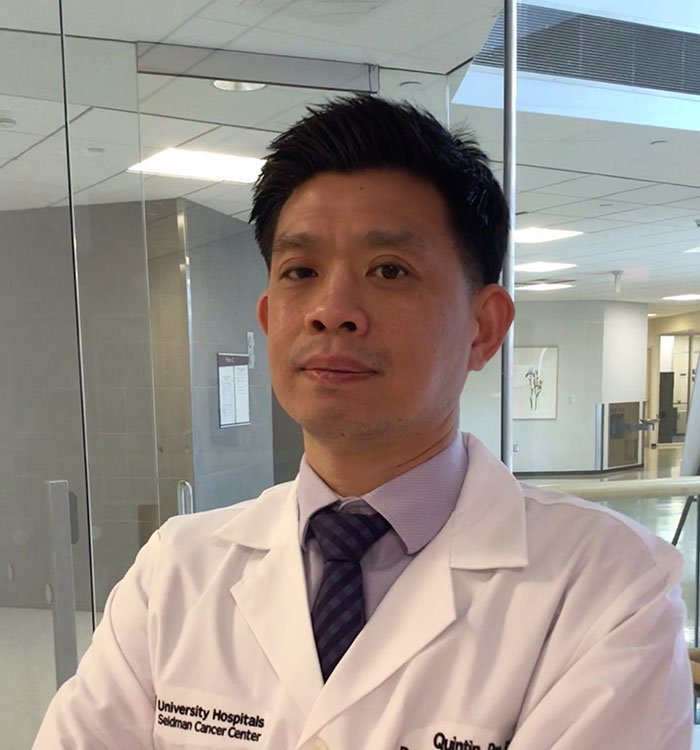HPV-Associated Head and Neck Cancer Treatment
March 12, 2020
UH researchers identify outlier HPV strain, study cancer stem cells
 Quintin Pan, PhD
Quintin Pan, PhDInnovations in Ear, Nose & Throat | Winter 2020
Risk factors associated with head and neck cancers have shifted during the past generation. Once primarily linked to tobacco and alcohol use, today 70 percent of oropharyngeal cancer is driven by the human papillomavirus (HPV), a sexually transmitted disease with more than 200 viral strains.
Researchers at University Hospitals Cleveland Medical Center and Case Western Reserve University School of Medicine are leading the way in identifying how various strains of HPV behave on a genetic level, unlocking the potential for development of novel immunotherapies and drug treatments. Two pivotal studies of their findings were recently published.
“HPV+ head and neck cancer patients typically respond better to standard treatment than [do] patients with HPV- head and neck cancer,” says Quintin Pan, PhD, Deputy Director for Research and Dr. Lester E. Coleman, Jr. Chair in Cancer Research and Therapeutics, University Hospitals Seidman Cancer Center; Professor, Department of Otolaryngology, , and Co-Leader, Molecular Oncology Program, Case Comprehensive Cancer Center. For HPV+ head and neck cancers, the current five-year survival rate is 85 percent, compared with 55 percent for HPV- cancers.
However, not all HPV+ oropharyngeal cancer statistics are as encouraging. “When you look at historical data, about 20 percent of patients fail within the first year,” notes Pan, who is also a professor in the Department of Otolaryngology at Case Western Reserve University School of Medicine and serves as Co-Leader of the Molecular Oncology Program at Case Comprehensive Cancer Center.
Also of concern are side effects of chemotherapy and radiation therapy. Patients often suffer lasting sequelae, such as difficulty with speech or swallowing. “The challenge in the field is that even when standard care paradigms work well, these toxic regimens result in quality of life issues for these patients,” says Pan. “If we are going to entertain the idea of delivering a less-intensive treatment, we need a biomarker to potentially identify patients who are not going to respond well.”
HPV 16 VERSUS HPV 33
HPV consists of more than 200 genotypes, of which at least 14 have been identified as high risk (cancer causing). “The key question we were interested in is whether different HPV genotypes matter in terms of prognosis,” says Pan. For both oropharyngeal and cervical malignancies, the strain identified as HPV 16 accounts for between 75 and 85 percent of cases. Though far less prevalent, the subtype HPV 33 is responsible for poorer outcomes.
Pan, along with Theodoros N. Teknos, MD, President and Scientific Director, UH Seidman Cancer Center, and their research team have demonstrated that HPV 33 is associated with an aggressive disease progression for up to 25 percent of patients with HPV+ oropharyngeal cancer. Dr. Teknos is also a Clinical Professor in the Department of Otolaryngology at the School of Medicine, and Deputy Director for UH at Case CCC.
Their recent study, published in Oral Oncology, is the first to link an individual HPV genotype to an inferior immunological response in patients. “Immune cells recognize tumors and destroy them,” says Pan. “We found that HPV 33 tumors are immunosuppressed, with a much lower number of infiltrating CD8+ T cells.”1
NEXT STEPS
Currently, HPV+ head and neck cancers are diagnosed using a surrogate biomarker — the p16 immunohistochemistry test. “The p16 assay is limiting because it is unable to differentiate between HPV genotypes,” says Pan. “We need to move beyond p16 and perform HPV genotyping to guide treatment decisions for head and neck cancer patients.” Additionally, this risk stratification could aid in determining whether the intensity and toxicity of current treatments could be reduced for patients with highly responsive HPV genotypes to lessen the burden of side effects without compromising survival outcomes.
CANCER STEM CELLS
In a landmark study published in Nature’s Scientific Reports2, the research team started with a hypothesis that HPV+ patients tend to do better than HPV- patients because they have fewer cancer stem cells. Their findings showed the opposite to be true.
Cancer stem cells repopulate tumors and are responsible for disease progression or recurrence. “The accepted dogma in the literature is that cancer stem cells are resistant to therapy. In general, the higher the number of cancer stem cells, the worse the prognosis,” says Pan. “Our data indicate that HPV+ tumors actually have a higher number of cancer stem cells than HPV- tumors, but they are more sensitive to treatment.”
By measuring the activity of aldehyde dehydrogenase (ALDH), a family of 19 different isoforms that marks cancer stem cells, the researchers found that HPV+ tumors were driven by overexpression of just one ALDH isoform. In contrast, study of HPV- tumors demonstrated that a number of ALDH isoforms were driving high activity.
“We concluded that cancer stem cells in HPV+ tumors are much more genetically homogeneous than HPV- tumors,” says Pan. “If we can profile an individual tumor to determine which ALDH isoforms are driving the cancer stem cell population, then perhaps we can use this information to offer ALDH isoform specific inhibitors.”
The incidence of HPV+ cancer is projected to rise in the coming decades, due to changes in epidemiology and population behaviors. “Understanding the biology and genetic expression behind these HPV+ head and neck cancers is critical so that we can develop precision treatment options in the future,” says Pan.
For more information, please contact Pan at 216-368-1122 or email Quintin.Pan@UHhospitals.org.
1Chatfield-Reed K, Gui S, O'Neill WQ, Teknos TN, Pan Q. HPV33+ HNSCC is associated with poor prognosis and has unique genomic and immunologic landscapes. Oral Oncology. January 2020, 104488. https://www.sciencedirect.com/science/article/pii/S1368837519303999?via%3Dihub
2Gui S, Xie X, O’Neill WQ, Chatfield-Reed K, Yu J-G, Teknos TN, Pan Q. p53 functional states are associated with distinct aldehyde dehydrogenase transcriptomic signatures. Scientific Reports. Jan. 23, 2020. https://www.nature.com/articles/s41598-020-57758-5


